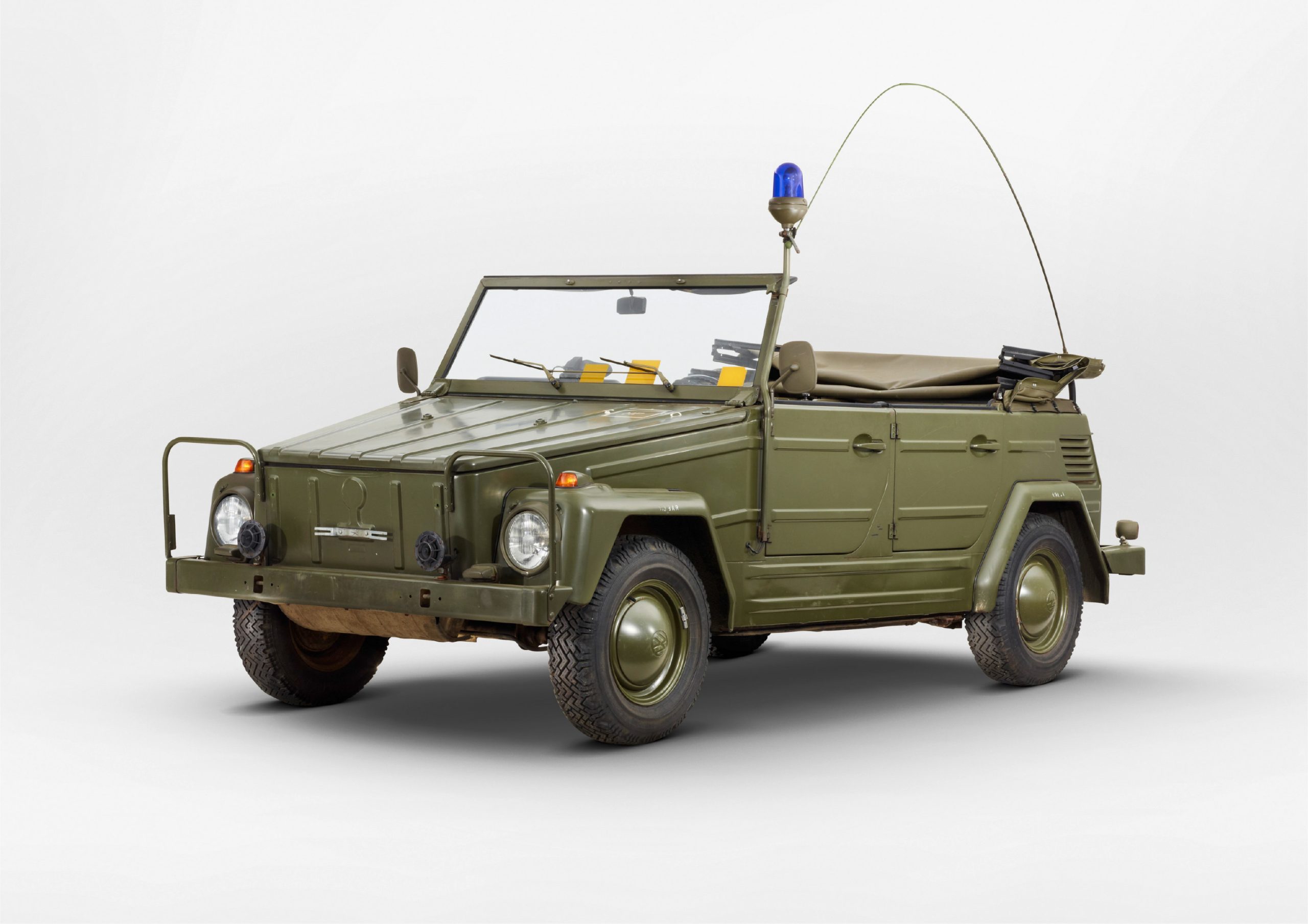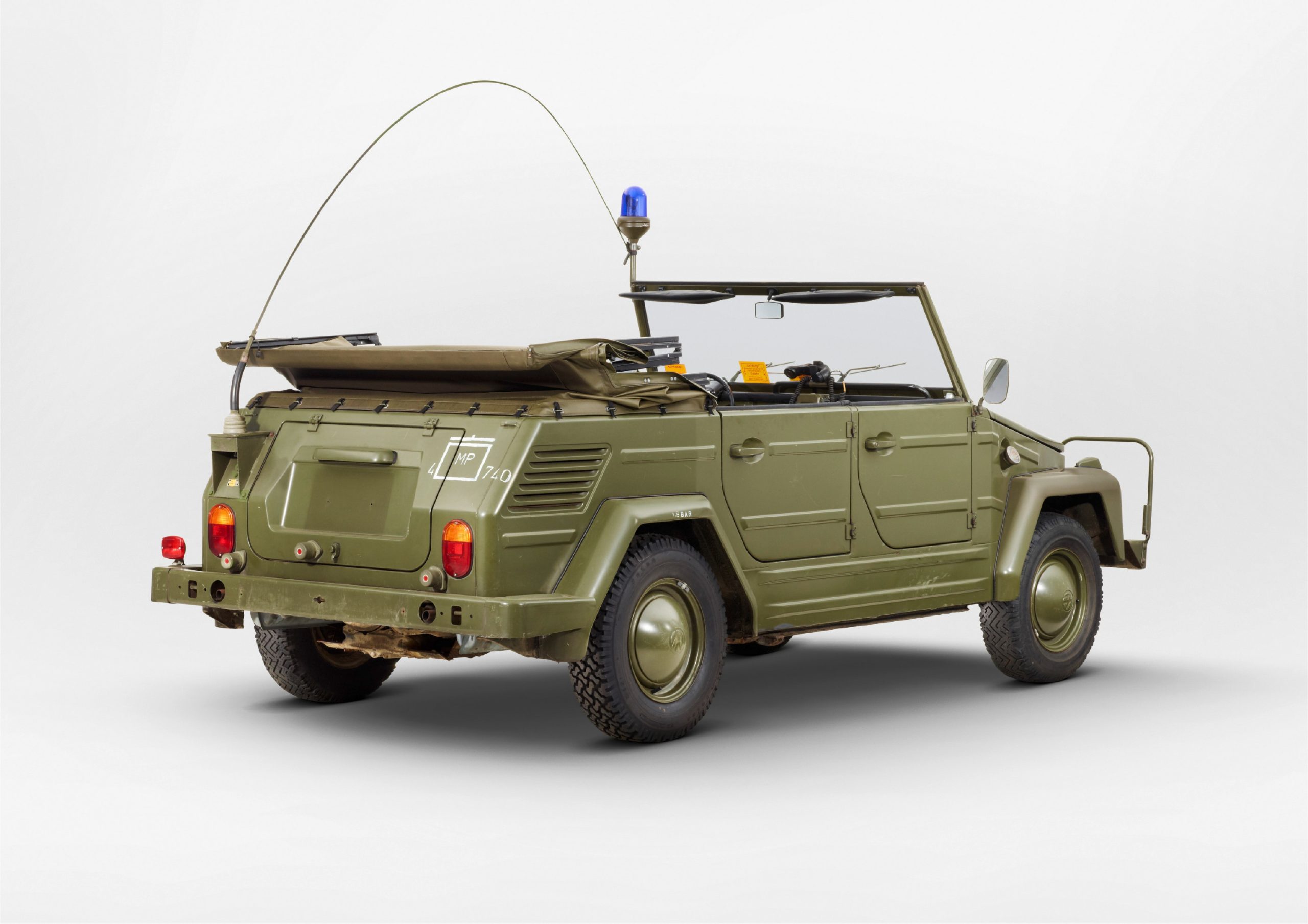Often (but incorrectly) called the “Kübel”, the VW 181 multi-purpose convertible was originally developed as a “conditionally off-road capable courier vehicle” for the Bundeswehr and was produced from 1969 onwards, but was mainly supplied to civilian customers. The 181 was based on the floor assembly of the Karmann Ghia Type 14; the T1 bus and Beetle provided the technology. Apart from increased ground clearance, it lacked everything to be a true off-roader, especially all-wheel drive. Even before the end of production in 1979, it achieved cult status, in the USA also as the fun car “The Thing”.
Often (but incorrectly) called the “Kübel”, the VW 181 multi-purpose convertible was originally developed as a “conditionally off-road capable courier vehicle” for the Bundeswehr and was produced from 1969 onwards, but was mainly supplied to civilian customers. The 181 was based on the floor assembly of the Karmann Ghia Type 14; the T1 bus and Beetle provided the technology. Apart from increased ground clearance, it lacked everything to be a true off-roader, especially all-wheel drive. Even before the end of production in 1979, it achieved cult status, in the USA also as the fun car “The Thing”.
The courier car’s career began as a “stopgap”. The German armed forces were faced with the problem that production of the DKW Munga was to end at the end of 1968. A joint development by France, Italy and Germany, the Europa Jeep, was planned as a replacement, but this international project did not get beyond the planning phase.
In the search for an alternative, the choice fell on Volkswagen. VW was to use the VW Beetle as the basis for designing the required multi-purpose vehicle with limited off-road capability. For the design, VW was able to draw on the Country Buggy developed in Australia and presented in 1967, which had been developed by Volkswagen technicians at the Australian assembly plant in Clayton Victoria. The engineers also took their cue from the VW Type 82 (Kübelwagen) of World War II.
In September 1969, when it was unveiled at the Frankfurt International Motor Show, the VW 181 proved to be a military vehicle in the style of the Kübelwagen, only slightly more modern, but larger and heavier. The boxy body with four half-doors was adapted to the intended use and the style of the time. The sales designation “Kurierwagen” was intended to avoid any connection to the Kübelwagen of the Wehrmacht. Nevertheless, it quickly received the nickname “Kübel” among the soldiers.
The body was bolted to a central tube platform frame (a platform of the Karmann Ghia Type 14 modified in various respects). The side rails (sills) of the co-supporting body provided the necessary torsional rigidity. For other components, existing and robustly manageable technology was used. The air-cooled 1.5-liter boxer engine with 44 hp (32 kW), clutch, instruments, steering and the 40-liter tank were taken from the VW Beetle 1500. The transmission and the rear axle with layshaft gearbox came, slightly modified, from the first VW Transporter discontinued in 1967.
Ground clearance was increased by using countershaft gears on the rear wheels. Four drum brakes provided adequate deceleration. The occupants were protected from the weather by an unlined all-weather soft top with a water-repellent PVC cover and so-called insertable polyglass windows. The front ones could be folded forward and locked in place with two push buttons.
The interior was heated exclusively by a gasoline-powered oscillating fire heater (parking heater), which had its place under the hood with the spare wheel at the front. The two-stage adjustable front seats were upholstered in hard-wearing imitation leather. The rear bench seat could be folded down completely or split, creating additional cargo space. A 1.6-liter engine was available just one year after the car’s introduction. By reducing the compression ratio from 1:7.5 to 1:6.6, the output of 44 hp remained unchanged, but allowed the use of even lower-grade fuels in worldwide service. The transmission was given a longer ratio at the countershafts; this increased the top speed to 115 km/h (previously 110 km/h).
Larger changes were made in 1973: The engine was more highly compressed and now produced 48 hp (35 kW) with the same displacement. The swing axle was replaced by a semi-trailing arm axle with double cardan shafts as in the VW 1302/1303. A design connection of the Beetle gearbox with a then current bus gearbox replaced the outdated countershaft design. Tire size was changed from 165 R 15 to 185 R 14. A fresh air heater replaced the obligatory parking heater in conjunction with large air intake boxes above the rear fenders so that no exhaust gases could be drawn in by the engine and enter the interior (using the same principle as the Beetle). Bundeswehr vehicles remained exempt, partly because of the extra cost, and partly because of the retained auxiliary heating and military exhaust system. The civilian version had a transverse pot similar to the Type 1.
Production of the “courier car” began in 1968 with 16 examples at the main plant in Wolfsburg. Series production then continued from October 1969. By March 1974, 57,574 units had been produced there. Production was then transferred to the Volkswagen plant in Hanover. A total of 10,629 vehicles left the assembly line in Hanover from April 1974 to July 1975. The last domestic production facility, with 2,323 units, was the VW plant in Emden (production ended in January 1978). In America, the “courier car” was sold with considerable success. In 1970 and 1971, so-called CKD kits were exported from Wolfsburg and assembled in the recipient country. From 1972, the VW Safari was built entirely in Mexico. The vehicles originating from this production can be recognized by the large-dimensioned “elephant-foot taillights” as on the VW Beetle 1303. From the beginning of 1978, however, VW 181s for the German Army with the original T1 tail lights were also built in Mexico and exported to Germany (an eagle crest with the note “Hecho en Mexico” can be found on the frame below the VIN). The end for the VW Safari in the USA came at the beginning of 1975. The Safari could not meet the newly enacted safety regulations for new vehicles there. However, it was sold in spite of the US ban, which meant that the



